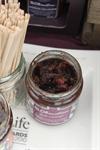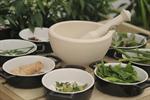 How to Make Food Taste Better
How to Make Food Taste Better
So far in this course we have described how to prepare foods from each of the 5 food groups. In this lesson we will consider how a basic dish may be transformed into a gourmet meal by using a complimenting stock, sauce, flavouring or garnish. To do this we will look at each of these in turn and consider basic preparation techniques and dishes where they can work particularly well.
Stocks
A stock is a liquid which is flavoured by meat, poultry and fish, including their bones, and from vegetables and seasonings. Making a quality stock involves the combination of suitable ingredients with correct preparation techniques. Stocks are extremely versatile and provide an ideal foundation for a variety of dishes such as in soups and sauces.
Making stock
A stock is made by simmering various ingredients in water. While it is possible to buy basic chicken/ meat and vegetable stocks, if you have enough time you will find that a homemade stock is able to confer a richer flavour to your final dish. Also, making your own stock allows you to utilise ingredients that would otherwise be thrown away e.g. chicken carcasses and the bones of roasted meat.
 Preparing a chicken stock
Preparing a chicken stock
When preparing a chicken stock use the raw carcass and chicken bones or wings or the previously roasted carcass from a cooked chicken. Put the bones into a large saucepan along with a large peeled onion chopped in half, a few peeled and halved carrots, 2 halved celery sticks. Add black peppercorns, a bay leaf and some of your favourite herbs e.g. a few fresh sprigs of thyme sprigs and some parsley stalks and bring the pan to a simmer. As you simmer your stock use a ladle to skim of any scum that floats to the top of the pan and ideally cook for about 2-3 hours, tasting often to ensure a good depth of flavour. Once your stock is cooked through pour the contents of the saucepan through a strainer/ colander into a large, clean bowl, and skim off any fat from the surface. Either use your stock straight away or refrigerate or freeze until it is required.
Preparing meat stocks
To prepare a meat stock use the same basic technique used to make a chicken stock but this time ensure that the bones from meat are roasted first. If you've are using the bones from beef or lamb place them into a large roasting tray with 2 unpeeled onions chopped in half and roast them in a hot oven for an hour until they are browned, then simmer bones as described above.
Preparing a vegetable stock
Vegetable stocks are a good base for numerous vegetable dishes, as well as for a variety of fish dishes. Vegetable stocks are an ideal way of using up parts vegetables that would otherwise be discarded. Your choice of vegetables should reflect those you most enjoy and also vegetables that are in season. Different vegetables also confer different flavours e.g. corn on the cob provides a distinctive sweet taste, while mushrooms can help to make a thicker ‘meatier’ vegetable stock. Be wary though of using vegetables that are past their best or those with a very strong taste which may overpower the flavour of other ingredients.
To make a basic vegetable stock wash and chop peelings from your chosen vegetables e.g. from carrots, parsnips and leeks and add to a large saucepan with one Celery stick and a variety of cauliflower, broccoli and asparagus stalks which have been washed and chopped.
Add 1 large onion, 6-8 peppercorns,1 teaspoon salt a few sprigs of fresh thyme and parsley or dried mixed herbs, 1 bay leaf and enough cold water to cover the contents of the saucepan or to make a reasonable amount of stock e.g. up to around 4 pints. Bring the stock to the boil then reduce heat and cover pan with a lid. Skim any surface scum with a ladle. Simmer for about 30 minutes before removing from the heat. Skim any surface scum that has formed then strain the stock into a bowl and allow cooling if refrigerating or freezing it.
General tips for cooking stocks
Remember to simmer and not boil your stock as boiling your stock will cause any surface scum to boil back into the stock.
If you feel that your strained stock is too weak reduce the stock in a cleaned-out to enhance its flavour.
If possible further reduce the fat content of your stock by leaving your stock to go cold and chill it overnight. This allows you to lift off any fat which may have solidified on top of the stock.
 Sauces
Sauces
The word "sauce" is a French word which is taken from the Latin word salsus, meaning salted. Use of sauces in cooking can be traced back thousands of years and even as far back as Roman times (200 AD) where sauces were used to disguise the taste of the food and also a lack of freshness. The most common sauces are made from 3 types of ingredients- a liquid which makes up the body of a sauce or the first layer of flavour, a thickening agent which adds substance and body to the sauce and a seasoning to give a sauce a second layer of flavour. We shall now look at each of these ingredients in turn.
Liquids
The particular liquid added varies according to the purpose of the sauce, e.g. whether it is to be served as an accompaniment to vegetables, fish, poultry or meat or as an integral part of pasta dishes like macaroni cheese. Stocks are among the main liquids used to make a sauce while other commonly used liquids include milk, cream, egg yolks and wine.
Thickeners
Thickeners are used to make sauces thick enough to coat foods. Types of thickeners include a roux which is a cooked paste made from wheat flour and fat, a starch solution made from starch and water e.g. cornstarch or vegetable/ potato starch, or a liaison thickener which is a mixture of cream and egg yolks that are added to a sauce at the end of the cooking time.
How to make a basic roux
To make a Roux you should use equal parts of all-purpose flour and fat e.g. 2 tbsp. butter or oil to 2 tbsp. of flour. A roux is identified by its color – a white roux is made with oil and cooked for a short time and is used in a sauce like bechamel or veloute sauce. A brown roux is cooked for longer and is commonly used to make gravies and in dishes such as stews. When using a roux to thicken a sauce it is important to add the roux correctly. If you are using a cool liquid such as a chilled stock, the cooler liquid should be added to the hot roux and you should whisk the mixture as you add the liquid to smooth out any lumps that may form. When adding a roux to a hot liquid gradually add enough hot liquid to dissolve the cold roux and then pour the dissolved roux into the simmering liquid. Sauces thickened with roux need to simmer at least 45 minutes to remove the starchy or pasty taste and gritty feel of the flour.
Thickening sauce with a starchy solution
A starch solution will thicken quicker than a roux. To use a starches, stir the starch e.g. cornstarch, together with a cold liquid until it dissolves and then gradually add the starch solution to a simmering liquid, stirring continually until the liquid thickens (this usually takes around 2-3 minutes).
Seasoning a sauce
Seasonings and additional flavourings add a 2nd layer of flavour to a sauce. The most basic seasonings are salt and pepper while other flavorings include aromatic vegetables, herbs, spices, and mustard. Some of these flavorings are described further on in the lesson.
Types of sauce
There are hundreds of different sauces whereas most chefs will use and adapt 5 grand sauces (or mother sauces) which are:
1. Brown sauce, which is a rich dark sauce typically served with meats. A brown sauce generally refers to a sauce with a meat stock base (e.g. those described earlier in this lesson), thickened by reduction or sometimes by the addition of a browned roux.
2. Veloute sauce, which is a white sauce made by thickening poultry, fish, or shellfish stock with a white roux. Veloute sauce works well with chicken and fish.
3. Bechamel sauce, which is a white sauce made by thickening milk with a white roux and as described in lesson 5 works well with different pasta dishes.
4. Tomato sauce, which is made by simmering tomatoes and flavoring ingredients such as basil or garlic until the tomatoes are soft enough to puree (see recipe 1). Tomato sauce works well with pasta and a variety of chicken and meat dishes.
5. Hollandaise sauce, which is made by blending melted butter into slightly cooked egg yolks. Hollandaise sauce works well with steak, eggs and vegetables such as broccoli and cauliflower (see recipe 2)
Tomato sauce (recipe 1):
To make a simple tomato sauce use as many tomatoes as desired but generally around 1.4kg (3lbs) of tomatoes will allow you to make around a pint of sauce. To make the tomato sauce, core each tomato, then cut in half and squeeze tomatoes expelling the seeds. Add the juiced halves into the large stock pot placed over high heat and use a wooden spoon to press the tomatoes. Once enough juice and water have accumulated, cover the pot and leave the tomatoes to cook for 20-30 minutes until pulped stirring intermittently. After tomatoes are cooked press them through a sieve and return the puree to a clean pan and add ½ a tablespoon of salt, 4 oz (110 g) granulated sugar, 1 teaspoon of paprika, a pinch of cayenne pepper and 1/4 pint (140 ml) distilled white vinegar. Stir the ingredients until the sugar has dissolved, bring to the boil and then reduce the heat and simmer gently until the sauce has thickened. A thicker sauce will be achieved by cooking the sauce for longer as this allows more of the excess water to evaporate.
Hollandaise sauce (recipe 2):
Add 3 egg yolks to a small saucepan and whisk until the egg yolks thicken (after about 1 minute) then whisk in 1 ½ tablespoons of lemon juice and 25g of chilled unsalted butter and place over very low heat. Whisk the sauce constantly while the butter is melting, and continue whisking until it begins to thicken enough so that the base of the saucepan becomes visible between strokes. At this point remove the pan from the heat and beat in an additional 25g of chilled butter. Finally, season the sauce with salt and pepper to taste.
Seasonings and additional flavourings
Herbs and seasonings are an essential ingredient of great stocks and sauces and can also be added directly to meats, baked goods and salads to impart flavour and aroma. In this section we shall consider some popular seasonings and flavourings and describe how to prepare them and use them to compliment different foods.
 Herbs
Herbs
Herbs do two common things in the kitchen
1. They replace salt and sugar as food flavourings. Which is good for our health as salt and sugar are often consumed in quantities which are detrimental to health.
2. They greatly expand the variety of tastes which can be experienced.
The quantity produced in a small garden, even off one plant, is frequently much more than would ever be used by one family. The only limitation to the availability of herbs is that your favourite culinary herbs might not produce at all times of the year. Even this, is not really a problem. Herbs can be harvested and kept many different ways ‑dried, frozen, preserved in oils or vinegar etc. until the time you are ready to use them.
Herbs can greatly increase the flavour of a meal, and can supply additional nutritional benefit. They can also increase the health of the vegetable garden. Herbs can be used in cooking many different ways; both as freshly picked parts off the plant, or as dried parts or products.
· Fresh - most have a stronger flavour if used fresh; and this use is generally preferred.
· Dried - many retain flavour well on drying; others do not.
· Products - herbs soaked in vinegar or oil transfer the flavour to the vinegar or oil. The vinegar or oil can then be used when preparing food to add the herb flavour.
Culinary Uses of Herbs
Culinary herbs make two important contributions to food preparation:
· They replace salt and sugar as food flavourings. Salt and sugar are widely known to be consumed by most people in quantities which are detrimental to health, so any move to replace them with an increased use of herbs is a positively healthy move.
· Herbs greatly expand the variety of tastes which can be experienced. They have been used since man’s earliest times to add to the flavour of food. With the tremendous variety of herbs now readily available, today’s cook can use them to provide interest in the form of colour and texture as well as flavour.
In cooking, herbs can be used freshly picked, dried or frozen. The treatment of herbs before cooking can, however, influence their flavour and appearance:
· Fresh herbs have a stronger flavour, and this use is generally preferred.
· Dried herbs are widely use in cooking. Many herbs retain flavour well on drying, but others to not. Also, the flavour will diminish with improper storage and time, so do not use very old dried herbs.
· Herbal infusions in vinegar or oil are often used for flavouring sauces, salads, etc. The flavour in herbs soaked in vinegar or oil transfers to the liquid, which can then be used when preparing food to add the herb flavour. The flavour will be less pronounced than the flavour of fresh herbs, which can be desirable. Herbs stored in vinegar or oil might need to be removed as they become old, but the infused flavour should remain for quite a while if the products are stored out of the light and in cool temperatures. Many medicinal uses of herbs require the production of herbal infusions.
· Herbal infusions in hot water are used to produce teas and tisanes.
Some Hints on Cooking with Herbs
· Grind dried herbs to get the best flavour. This may be done using a mortar and pestle, or simply the back of a spoon.
· Never cook fresh chervil as heat destroys the flavour. Add just before serving. (Chives are similar.)
· Do not shake leaves from a storage container into cooking food as vapour from the cooking can get into the container and cause the dried herbs to spoil.
· Do not store herbs next to the stove or in sunlight, as heat can reduce their flavour.
· To keep fresh herbs longer, stand with stems in a container of water, keeping the leaves dry, in a refrigerator.
· If you do need to wash herbs, make sure that the leaves are fully dried, spread them out on a wire rack in a single layer and allow water to evaporate before tying in bundles or freezing.
Learn More
Study our Food Prepartation Course http://www.acs.edu.au/courses/food-preparation-foundations-of-cooking-572.aspx